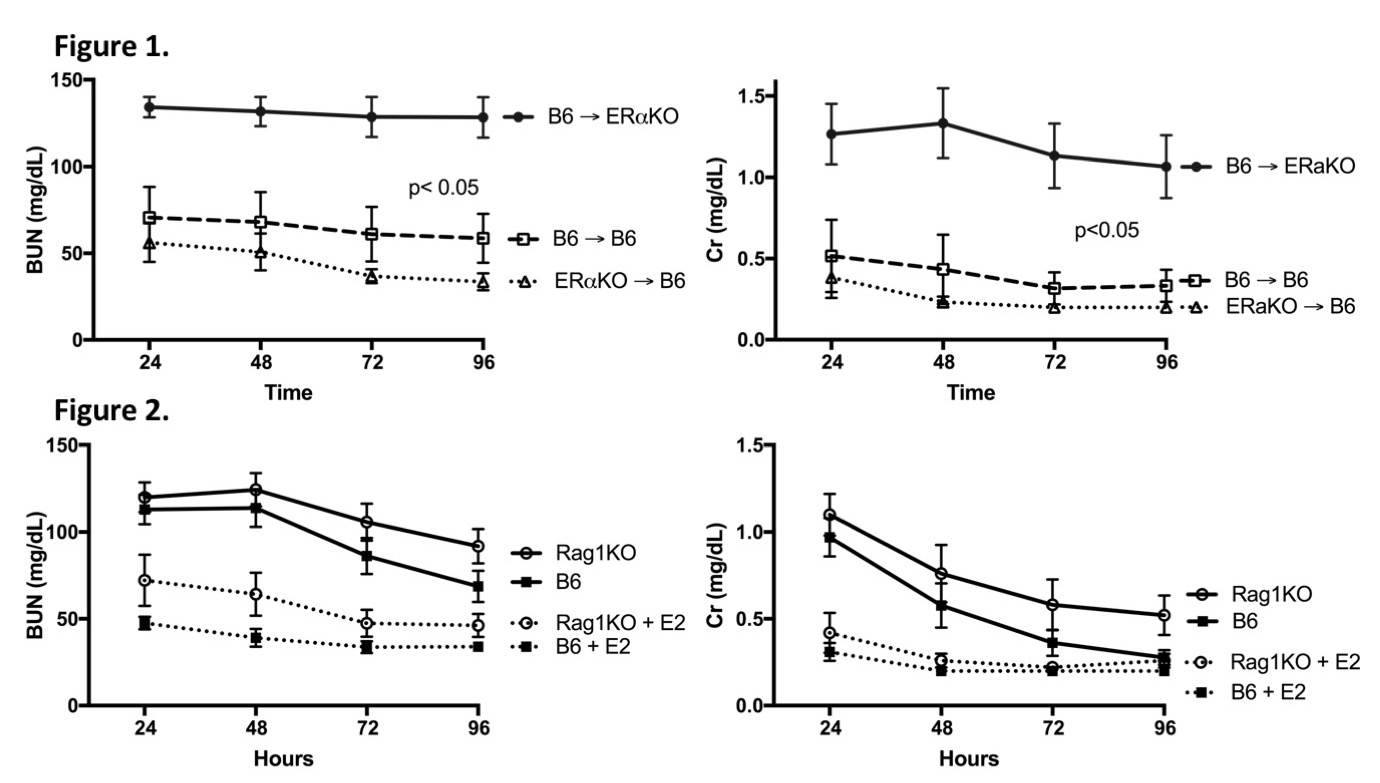Tissue Specificity and the Role of Lymphocytes in Estrogen-Mediated Protection from Renal Ischemia Reperfusion Injury
Hospital of the University of Pennsylvania, Philadelphia, PA
Meeting: 2020 American Transplant Congress
Abstract number: 519
Keywords: Ischemia, Kidney transplantation, Renal ischemia
Session Information
Session Name: Basic: Ischemia Reperfusion & Organ Rehabilitation III
Session Type: Oral Abstract Session
Date: Saturday, May 30, 2020
Session Time: 3:15pm-4:45pm
 Presentation Time: 3:15pm-3:27pm
Presentation Time: 3:15pm-3:27pm
Location: Virtual
*Purpose: Renal ischemia reperfusion injury (IRI) is a major contributor to delayed graft function (DGF) in kidney transplantation. We previously demonstrated lower rates of DGF among female renal transplant recipients in the UNOS registry, and using a murine model, we showed improved IRI tolerance with administration of supplemental 17β-estradiol (E2) in both warm and cold ischemia. We also showed decreased ischemia tolerance in estrogen receptor α knockout mice (ERαKO). Given the potential for E2 as a therapeutic intervention in renal transplantation, we further investigate the mechanism and tissue specificity of this estrogen-mediated IRI tolerance using a mouse renal transplant model and a lymphocyte-deficient mouse model
*Methods: We transplanted kidneys from C57BL/6(B6) donor mice into B6 recipient mice, ERαKO kidneys into B6 recipients, and B6 kidneys into ERαKO recipients, followed by native nephrectomy. All groups were treated with E2 and subsequently underwent standardized renal IRI. In a separate experiment, female recombination activating gene-1 knockout mice (Rag1KO) and B6 mice treated with either E2 or vehicle control underwent renal IRI. In both experiments, blood urea nitrogen (BUN) and serum creatinine (Cr) were measured at 24-, 48-, 72- and 96-hours after surgery.
*Results: ERα-KO mice that received B6 kidneys (B6–>ERαKO) had significantly higher BUN and Cr compared to B6 mice that received B6 kidneys (B6–>B6) or B6 mice that received ERαKO kidneys (ERαKO–>B6) (Figure 1). Rag1KO mice and B6 mice had similar BUN(p=0.25) and Cr (p=0.19) after IRI, and when treated with E2, both groups had lower BUN (Rag1KO p=0.002, B6 p=<0.001) and Cr (Rag1KO p=0.03, B6 p=0.002) after IRI compared to their respective controls (Figure 2).
*Conclusions: Loss of estrogen-derived protection from warm IRI in the ERα-KO recipient of a B6 kidney indicates that the mechanism for estrogen-derived protection is extrinsic to the kidney. We hypothesize that supplemental E2 is therefore protecting from IRI by modulating the recipient immune system. Protection from IRI in E2-treated Rag1KO group suggests that lymphocytes are not the effectors, implicating cells of the myeloid lineage. These data provide new insights into the mechanisms by which estrogen-based therapy can improve early outcomes in renal transplantation.
To cite this abstract in AMA style:
Hernandez PT, O'Brien CS, Concors SJ, Krumeich LN, Wang Z, Ge G, Hancock W, Levine MH. Tissue Specificity and the Role of Lymphocytes in Estrogen-Mediated Protection from Renal Ischemia Reperfusion Injury [abstract]. Am J Transplant. 2020; 20 (suppl 3). https://atcmeetingabstracts.com/abstract/tissue-specificity-and-the-role-of-lymphocytes-in-estrogen-mediated-protection-from-renal-ischemia-reperfusion-injury/. Accessed December 26, 2025.« Back to 2020 American Transplant Congress

